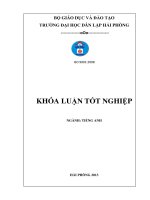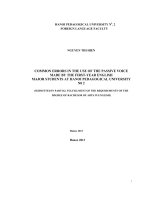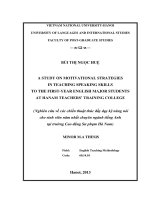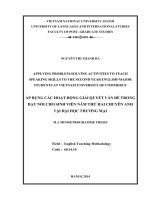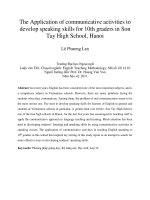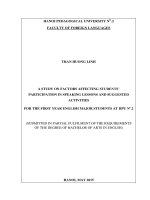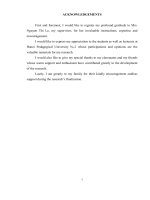The effectiveness of using skyde to improve speaking skills for the first year english education students at Ha Noi Pedagogical University 2
Bạn đang xem bản rút gọn của tài liệu. Xem và tải ngay bản đầy đủ của tài liệu tại đây (1.84 MB, 116 trang )
HANOI PEDAGOGICAL UNIVERSITY 2
FOREIGN LANGUAGES FACULTY
-----------------
TỐNG HUỆ PHƯƠNG
THE EFFECTIVENESS OF USING SKYPE TO IMPROVE
SPEAKING SKILLS FOR THE FIRST YEAR ENGLISH
EDUCATION STUDENTS AT HANOI PEDAGOGICAL
UNIVERSITY 2
(SUBMITTED IN PARTIAL FULFILLMENT OF THE REQUIREMENTS
OF THE DEGREE OF BACHELOR OF ARTS OF ENGLISH)
BA THESIS IN ENGLISH
HANOI, 2017
HANOI PEDAGOGICAL UNIVERSITY 2
FOREIGN LANGUAGES FACULTY
-----------------
TỐNG HUỆ PHƯƠNG
THE EFFECTIVENESS OF USING SKYPE TO IMPROVE
SPEAKING SKILLS FOR THE FIRST YEAR ENGLISH
EDUCATION STUDENTS AT HANOI PEDAGOGICAL
UNIVERSITY 2
(SUBMITTED IN PARTIAL FULFILLMENT OF THE REQUIREMENTS
OF THE DEGREE OF BACHELOR OF ARTS OF ENGLISH)
BA THESIS IN ENGLISH
SUPERVISOR: NGUYỄN THỊ HÀ ANH, MA
HANOI, 2017
ACKNOWLEDGEMENTS
I would like to express the deepest appreciation and my sincere thanks to
my supervisor: Ms. Nguyen Thi Ha Anh, M.A., for her guidance as well as
encouragement, indispensable suggestions and advice.
I want to express my sincere gratitude to the committee members for their
time, advice and valuable feedback that were invaluable.
In addition, I like to thank the first year students of English Education for
their support and enthusiasm with my research. A special thank goes to the
students who were participating in my survey, a crucial component of my
research.
i
ABSTRACT
As a result from the practical issue that students‟ English speaking skills
are quite poor and their attitudes towards learning speaking English outside class
are passive, the researcher was inspired to use Skype computer program to help
them. In general, the English language speaking sub-skills focused are
comprehension, fluency, vocabulary, pronunciation and grammar.
This study aims at investigating the effectiveness of using Skype on a
group of three first year students of English Education at Hanoi Pedagogical
University 2 (HPU2) in English speaking skills. The results collected from two
tools: the speaking test interview to measure the students' speaking skills
achievements and the survey questionnaire to determine the changes towards the
improvement of speaking skills outside class due to the implementation of
Skype.
Based on the results of the pre-speaking test interview and the pre survey
questionnaire, the researcher had concluded that not only students‟ English
speaking was low, but their errors in English speaking sub-skills were numerous,
consequently the application of Skype outside class was scheduled with a
number of topics for practice discussion.
Resulting from the post-speaking test interview and the post survey
questionnaire, the employment of Skype was demonstrated that it was effective
in improving students‟ speaking ability and their attitudes towards practicing
speaking outside class.
ii
STATEMENT OF AUTHORSHIP
I state that the thesis is truly my original work. The thesis does not contain
any material which has been written or published by another person except
where referenced within the text.
Date submitted: May 2017
Student
Supervisor
Tong Hue Phuong
Nguyen Thi Ha Anh, MA
iii
LIST OF ABBREVIATIONS
Hanoi Pedagogical University 2
HPU2
Student 1
S1
Student 2
S2
Student 3
S3
Computer-Assisted Language Teaching
CALL
Second Language Acquisition
SLA
Student Oral Language Observation Matrix
SOLOM
iv
TABLE OF CONTENTS
PART I
INTRODUCTION
I. RATIONALE ..........................................................................................................................1
II. RESEARCH QUESTIONS ............................................................................................2
III. RESEARCH OBJECTIVES........................................................................................3
IV. RESEARCH SCOPE .......................................................................................................3
V. RESEARCH TASKS .........................................................................................................4
VI. RESEARCH METHODOLOGY ..............................................................................4
VII. SIGNIFICANCE ..............................................................................................................5
VIII. RESEARCH DESIGN.................................................................................................5
PART II
DEVELOPMENT
CHAPTER 1: LITERATURE REVIEW
I.1. English speaking skills ....................................................................................................7
I.1.1. Definitions of speaking ................................................................................................7
I.1.2.English language speaking skills .............................................................................9
I.1.3. English language speaking sub-skills ..................................................................9
I.1.3.1. Accuracy ..........................................................................................................................9
I.1.3.2. Fluency............................................................................................................................10
I.1.3.3. Pronunciation ...............................................................................................................11
I.1.3.4. Grammar ........................................................................................................................12
I.1.3.5. Vocabulary ....................................................................................................................12
I.1.3.6. Comprehension ............................................................................................................13
I.2. The employment of technology in English speaking classroom ..............13
I.2.1. Technology and Language ......................................................................................13
v
I.2.2. History of using technology in language classrooms .................................14
I.2.3. Online discussion..........................................................................................................16
I.2.4. Communication software.........................................................................................17
I.3. Skype ......................................................................................................................................17
I.3.1. Concepts of Skype .......................................................................................................17
I.3.2. Benefits of using Skype in learning languages ..............................................18
I.3.3. Challenges of using Skype in learning language …………………..…..…………….18
I.4. The previous studies .......................................................................................................19
CHAPTER 2: METHODOLOGY
II.1. Research methods..........................................................................................................23
II.1.1. Rationales behind the case study .......................................................................23
II.1.2. Case study research procedure...........................................................................25
II.1.2.1. Describing background .......................................................................................25
II.1.2.2. Identifying problems ............................................................................................26
II.1.2.3. Producing vision/objectives ..............................................................................26
II.1.2.3. Proposing solutions ...............................................................................................26
II.1.2.4. Implementing case study ....................................................................................26
II.1.2.5. Results and evaluation.........................................................................................27
II.2. Data collection instruments ......................................................................................27
II.2.1. Speaking test interview ...........................................................................................27
II.2.1.1. Pre-speaking test interview ...............................................................................27
II.2.1.2. Post- speaking test interview ............................................................................28
II.2.1.3. Checklist .....................................................................................................................28
II.2.2. Survey questionnaire ...............................................................................................29
II.2.2.1. The pre-survey questionnaire ..........................................................................29
II.2.2.2. The post-survey questionnaire ........................................................................29
II.3. Research setting ..............................................................................................................30
vi
II.4. Participants .......................................................................................................................30
II.5. Research procedure ......................................................................................................31
II.5.1. Describing the background...................................................................................31
II.5.2. Identifying problems ................................................................................................31
II.5.3. Producing vision/objectives ..................................................................................32
II.5.4. Proposing solution .....................................................................................................32
II.5.5. Implementing case study ........................................................................................33
II.5.6. Results and evaluation ............................................................................................34
II.6. Data analysis ....................................................................................................................34
II.6.1. Test interview...............................................................................................................34
III.6.1.1. Oral test interview ...............................................................................................34
II.6.1.2. Interview’s checklist .............................................................................................34
II.6.2. Survey questionnaire ...............................................................................................35
CHAPTER 3: RESULTS AND DISCUSSIONS
III.1. Description of procedure and the outcome ....................................................36
III.1.1. Week 1 ...........................................................................................................................36
III.1.2. Week 2 ...........................................................................................................................38
III.1.3. Week 3 ...........................................................................................................................39
III.1.4. Week 4 ...........................................................................................................................40
III.1.5. Week 5 ...........................................................................................................................41
III.1.6. Week 6 ...........................................................................................................................43
III.1.7. Week 7 ...........................................................................................................................43
III.2. The results from the speaking test interview ...............................................45
III.2.1. Result from the pre-speaking test interview ..............................................46
III.2.1.1. Comprehension ........................................................................................................47
III.2.1.2. Fluency ........................................................................................................................48
III.2.1.2.1. Non-lexical words repetition ..........................................................................48
vii
III.2.1.2.2. Lexical words pronunciation repetition ......................................................49
III.2.1.3. Vocabulary .................................................................................................................50
III.2.1.3.1. Words‟ pronunciation ........................................................................................50
III.2.1.3.2. Limited vocabulary also causes words usage reiteration ....................51
III.2.1.4. Pronunciation ............................................................................................................51
III.2.1.4.1. Stress and Intonation ..........................................................................................51
III.2.1.4.2. English consonants .............................................................................................52
III.2.1.5. Grammar .....................................................................................................................53
III.2.1.5.1. Wrong verb tense .................................................................................................53
III.2.1.5.2. Subject-verb disagreement...............................................................................54
III.2.1.5.3. Clipped sentences ................................................................................................54
III.2.2. Result from the post-speaking test interview...................................................56
III.2.2.1. Comprehension ........................................................................................................57
III.2.2.2. Fluency ........................................................................................................................57
III.2.2.2.1. Non-lexical words repetition ..........................................................................57
III.2.2.2.2. Lexical words pronunciation repetition ......................................................57
III.2.2.3. Vocabulary .................................................................................................................58
III.2.2.3.1. Words‟ pronunciation ........................................................................................58
III.2.2.3.2. Words‟ reiteration ...............................................................................................58
III.2.2.4. Pronunciation ............................................................................................................59
III.2.2.4.1. Stress and Intonation ..........................................................................................59
III.2.2.4.2. English consonants .............................................................................................59
III.2.2.5. Grammar .....................................................................................................................60
III.2.2.5.1. Wrong verbs tense ...............................................................................................60
III.2.2.5.2. Subject verb disagreement ...............................................................................60
III.2.2.5.3. Clipped sentences ................................................................................................61
III.2.3. Comparison and evaluation ...............................................................................61
viii
III.3. Results from survey questionnaire .....................................................................63
III.3.1. Students’ attitudes toward English speaking skills................................63
III.3.2. Students’ attitudes toward using Skype to practice speaking ..........65
III.3.3. Challenges facing the students in using Skype to practice speaking
............................................................................................................................................................67
PART III
CONCLUSION
I. Summary of the study .......................................................................................................68
II. Limitations ............................................................................................................................69
III. Recommendations …………………………………………………………………...…70
REFERENCES .................................................................................................. 73
APPENDIX A .................................................................................................... 81
APPENDIX D .................................................................................................... 86
APPENDIX E .................................................................................................... 93
APPENDIX F ..................................................................................................... 94
APPENDIX G .................................................................................................. 103
ix
PART I
INTRODUCTION
I. RATIONALES
Human beings can never live in isolation; they share the planet so they
need to exchange messages with their partners for specific purposes. They
need to share messages about their needs, passions, pains, anger, favorites,
dreams, plans, and discoveries. They also need to find different means to
exchange messages about these different purposes.
English as an international language is used by the wider communities
rather than its native speakers (Mckay, 2002: 5). It is spoken, learnt and
understood even in those countries where it is not a native language. It plays
an important role in everyday situations all over the world and deals with all
aspects of life. It is the language of science, information, technology, politics,
economics and education (Hamdona, 2007).
Speaking is one of the four language skills. It is a productive and active.
Speaking helps students produce those units of meaning in phrases and
clauses, not just word by word (Gruber-Miller, 2006: 12). Speaking is an
interactive process of constructing meaning that involves producing, receiving
and processing information (Brown; 1994; Burns & Joyce, 1997). However,
English is a language that has a number of differences in pronunciation, word
formation, grammar, spoken expressions… from others that make so many
barriers for learners from other countries to imply it fluently as a second
language.
A student has learned English for 9 years, even 12 years cannot
introduce themselves well and correctly in English, because they only focus
on traditional books which are full of grammar structures and words. They
1
lack of English practice environment to improve and motivate them to use
English in daily communication in real life. That is the reason why many first
year English major students reported that they have to deal with a large
number of difficulties in speaking skills study.
Due to this problem, the development of IT in the recent modern
century solves this problem in the quickest and most effective way. There has
been an invented software which connects users all over the world, allows
them to make a call, chat and watch their face like real talk, send files also,
without any cost whenever their computers or phones are connected to the
Internet called Skype. In addition, because of the long geographical distance,
each student has been equipped by own laptop and cell phone which are
connected to the Internet and comfortably installed Skype that have
opportunities of English speaking practice. Today there are more than 630
million users of Skype. This number rises sharply every day and every time.
With the purpose of helping first-year students of English Education at
HPU2 enhance their English speaking skills, this study focuses on the training
of English conversation whereby some native speakers of English and nonnative but advanced English speakers function as Conversation Facilitators
(CFs) using audio conferencing- Skype to talk with a small group of students
or converse one-to-one. This process focuses on the speaking sub-skills such
as comprehension, fluency, vocabulary, pronunciation and grammar practice.
II. RESEARCH QUESTIONS
Speaking is one of the most important skill of language learners so that
it is vital for first year students to have a proper method of improvement,
particularly they would need this skill almost all the years at university life,
but also in reality. Students can learn better at home than in class with good
learning materials, effective networks, and proper support. Many students are
2
drawn to online courses because they both want and need to determine the
time and place of their learning (Lynch, 2004: 16). From this case, Skype was
discovering and applied in this thesis and the following questions form the
basis of this study:
1. How effective is the employment of Skype in English speaking skills
practice among the first year students of English Education at HPU2?
2. What are attitudes of the first year students of English Education towards
using Skype to practice English speaking outside class?
III. RESEARCH OBJECTIVES
This research focuses on the speaking skills of first year students of
English Education at HPU2. The study is aimed at the following objectives:
1. To help the first year students of English Education at HPU2 be better at
speaking skills.
2. To point out which sub-speaking skill can be most improved after the
application of Skype?
3. To find out whether the first year students of English Education at HPU2
are interested in using Skype as English speaking practice tool outside class.
IV. RESEARCH SCOPE
The main subject of the research is using Skype to improve English
speaking skills of the first year students of English Education at HPU2 in
outside class.
The participants involved in the study are a group of three first year
students at Pre- Intermediate level of Course 42 of English Education Class in
the Foreign Languages Faculty at HPU2. The research intended to discover
Skype as a new application tool to enhance students‟ speaking skills outside
class. English speaking class are clarified specifically into five sub-skills
focused on Comprehension, Fluency, Vocabulary, Pronunciation and
3
Grammar. This thesis can be also be beneficial not only English major
students, but other languages and even for people who are not major in
English and who have intention to learn it as a second language.
V. RESEARCH TASKS
The study involves fulfilling the following tasks:
1. Describe a general view of both the speaking definitions; subspeaking skills, English speaking inside/outside class and Skype application
such as the definitions of Skype, benefits of using Skype.
2. Describe Skype applying process, by what way Skype is carried out
among students.
3. Conduct a pre- speaking test interview to find out which level
students are belonging to sub- speaking skills such as comprehension, fluency,
vocabulary, pronunciation and grammar.
4. Conduct a post- speaking test interview to find out how English
speaking skills of first year students of English Education effective by
applying Skype as a tool improvement outside class.
VI. RESEARCH METHODOLOGY
A case study approach was taken in this study. With the purpose of
enhancing students‟ speaking competence through Skype application, the
thing, which the researcher completed, was to review some relevant
publications. Then the researcher consults with supervisors and friends to
produce pre- interview. A number of topics and evaluated criteria as below
were presented. During seven weeks applying Skype speaking skills practice
the researcher would participate in the conversation discussion, observe the
participants‟ improvement. Based on the topics‟ questions and situations
prepared, the learners discuss and express their thoughts. Finally, the postinterview was produced to evaluate students‟ progress in speaking skills.
4
Then the researcher would collect data from the post-interview‟s result and
analyze them to determine how effective in English speaking skills they
improve by applying Skype computer program and which sub-speaking skill
they tend to be practiced the best.
VII. SIGNIFICANCE
After the research, it is hoped that the results will be helpful with not
only students in improving English speaking skills outside class, but also
teachers as a vital materials of their instruction in teaching methodology to
increase students‟ English speaking competence.
Otherwise, the thesis is significant for students who are nonprofessional linguistic learners and teachers as well as anyone who takes an
interest in speaking skills improvement.
VIII. RESEARCH DESIGN
This research work has three parts, namely: the Introduction,
Development, and Conclusion.
Part 1: The “Introduction” consists of the rationales, the
objectives, the questions, the scope, the method, the significance and the
design of the study.
Part 2: The “Development” part consists of four chapters:
- Chapter 1 is entitled “Literature Review”. The chapter reviews
the previous studies, the definition and English language speaking skills,
English speaking sub-skills, English speaking learning inside and outside
class, technology and language, Skype‟s definitions and its benefits.
- Chapter 2 is named “Methodology”. It includes the rationales
behind using the research method is this research. It is composed of the
description of the subjects and the procedures of making research.
- Chapter 3 named “Results” shows the results in detail.
5
Part 3 is the “Conclusion” provides the summary, limitations of
the study and suggested some ideas for further studies.
6
PART II
DEVELOPMENT
CHAPTER 1: LITERATURE REVIEW
I.1. English speaking skills
I.1.1. Definitions of speaking
Speaking is defined as an interactive process of constructing meaning
that involves producing, receiving and processing information. Its form and
meaning are dependent on the context in which it occurs, the participants, and
the purposes of speaking (Burns & Joyce, 1997). In addition, speaking is the
form of oral correspondence between the speaker and the hearer in
transforming ideas for reaching the goal of communication (Taufiqulloh,
2009 ).
Moreover, according to Nunan, he states that: “Speaking is the ability
in using oral language to explore ideas, intentions, thoughts, and feeling to
other people as the way to make the message clearly delivered and well
understood by the hearer”. (1995). Together with this idea, Merrian, the
author of “Webster Online Dictionary” (2002), mentions speaking definition:
“Speaking is uttering words or articulating sound with ordinary voice.
Speaking is the way to convey thought, opinion, emotion orally, or to express
oneself.” This means speaking is performing thoughts, feelings, attitudes and
so forth understandably through using words.
Meanwhile, speaking is the productive skill in which students utter
words and sentences for specific purposes to convey certain messages using
the appropriate grammatical rules, vocabulary and score of formality with the
atmosphere of confidence and comfort. Continuing with that concept, Brown
also comments that: “Speaking is an interactive process of constructing
7
meaning that involved producing information. Its form and meaning are
dependent on the context, in which it occurs, including the participants
themselves, their collective experience, the physical environment and the
purpose of speaking.” (1983:17). This means that when speaking, we need to
take notices of factors affecting successful communication such as: the
content we are talking about, the person we are talking to, the context of the
communication, the reason why we are taking part in this communication, the
way we express ideas in our minds and so on.
However, Bygates emphasizes, “speaking is not only knowledge about
language, it is a skill which cannot be developed without adequate training
and practice.” (Bygate, 1987:3). As peaking is the most effective tool to
communicate with each other, in daily life, we have to face with many
complicated situations that require us to solve cleverly. Moreover, speaking
also shows speaker‟s level. Therefore, a successful speaker is a person who
must be good at choosing the reasonable form of speaking and knows how to
express opinions. In short, it is impossible for learners to be successful in
speaking with the basic knowledge of the language such as: vocabulary,
grammar, pronunciation…without any practice.
Although not only English- majored students in the first year at HPU2,
but non English-major others have improved this subject for more ten years,
their speaking skills are limited, due to studying habits at high school such as
grammar focus, examinations focus and their passivity in learning a language.
According to Widdowson (1994), speaking is the active production skill and
use of oral production. It is the capability of someone to communicate orally
with others. Thus, it is vital to map out the new way to motivate and
encourage students‟ study as new method to make different in learning
English communication.
8
Speaking is defined operationally in this study as the secondary stage
students' ability to express themselves orally, coherently, fluently and
appropriately in a given meaningful context to serve both transactional and
interactional purposed using correct pronunciation, grammar and vocabulary
and adopting the pragmatic and discourse rules of the spoken language. In
other words, they are required to show mastery of the following sub
competencies/ skills.
I.1.2. English language speaking skills
Speaking is a skill, which deserves attention every bit as much as
literary skills, in both first and second language. Learners of a language need
to be able to speak with confidence (Bygate, 2003).
Speaking is the productive skill in which students utter words and
sentences for specific purposes to convey certain messages using the
appropriate grammatical rules, vocabulary and score of formality with the
atmosphere of confidence and comfort.
Learning to speak English confidently is nowadays a need. It is no
more an issue of status however it is of supreme necessity for a good quality
job and to flourish in one‟s career. Even in the management jobs the high
profile people also require a fluency in English. Yet again, it is not just to
leave an impression of stylishness however it is necessary to converse your
important points in a smart way. Usually people are able to easily make their
point work in their own goodwill, if they are able to intermingle appropriately
and present their points in an open platter.
I.1.3. English language speaking sub-skills
I.1.3.1. Accuracy
Accuracy in speaking is the use of correct forms of grammar,
vocabulary and pronunciation (Spratt, Pulverness & Williams, 2005:34).
9
Speakers express themselves with the correct sociolinguistic competence
(Ano, 2001).
Arndt, Harvey, & Nuttall (2000: 149) claims that fluency and
appropriacy are the main criteria for successful language use. Appropriacy is
the process of selecting the content of the communication and formulation of
the message based on the speaker's intention (Kaplan, 2010: 64) and cultural
backgrounds (Arndt, Harvey & Nuttall, 2000:150).
We are considered to be proper users of a language if we use all words
in the correct conduct; correct grammar system, correct sentences in a correct
situation. A speaker needs to explain how and why they adapt their systemic
knowledge of language to real world use, involving judgments of appropriacy
at all levels; discourse, lexico-grammatical, or articulatory (Kaplan, 2010: 64)
levels.
Appropriacy is an important sub-skill in the productive skills; speaking
and writing. However, it is a must in spoken language. It can be shown in
three types; sociolinguistic, socio-cultural and social appropriacy (Ek,1992:
71).
I.1.3.2. Fluency
Thornbury (2005) defines fluency as the ability to converse or to
express a sequence of ideas fluently, but what is fluently or fluency? Fluency
can be defined as the features of a second language oral performance that
serve as reliable indicators of how efficiently the speaker is able to mobilize
and temporally integrate, in a nearly simultaneous way, the underlying
processes of planning and assembling an utterance in order to perform a
communicatively acceptable speech act. It is the ability to describe and report
actions or situations in precise words (Segalowitz, 2010: 47).
10
According to Wikipedia 2013, Harrell (2007) defines fluency as a
speech language pathology term which means the smoothness or flow with
which sounds, syllable, words and phrases are joined together when speaking
quickly.
People can be said as fluent speakers if their speaking includes the
pauses management by, fit timing, correctness fill, meaningful transition
points and words between pauses. Foster and Skehan in Nunan (2004)
propose a model in assessing speaking fluency by considering the total
number of seconds of silence and time spent saying „um‟ and „ah‟ by subjects
as they complete a task.
People can be said as fluent speakers if their speaking includes the
pauses management by, fit timing, correctness fill, meaningful transition
points and words between pauses. Foster and Skehan in Nunan (2004)
propose a model in assessing speaking fluency by considering the total
number of seconds of silence and time spent saying „um‟ and „ah‟ by subjects
as they complete a task. With the same idea, Tumova (2002) states that
fluency means speaking the language freely to express ideas in real-life
situations regardless of making mistakes. Castaneda, & Roderquez-Gonzalez
(2011) add that fluency means to speak smoothly and continually without
stopping to think of selecting the correct word.
I.1.3.3. Pronunciation
Students will always be confident if they are not afraid of making
mistakes while producing the language. Thornbury (2005) defines
pronunciation as the student‟s ability to produce comprehensible utterances to
fulfill the task requirements. In a wider meaning, Dalton (1994) defines
pronunciation as the production of significant sounds in terms of pure sounds
and meaningful sounds in contexts.
11
Harmer (2001) provides pitch, intonation, minimal pairs, spelling,
rhythm, and stress, as issues related to pronunciation. Kenworthy (1987) lists
stress and pitch as various components of sounds and learners need to
understand the function of such components as well as their form.
Pronunciation is of important significance as a part of any language
code in which we can distinguish English, Arabic, or Russian. As well as,
pronunciation is important to achieve meanings being conveyed within a
context. Here, codes are combined with other factors to make communication
possible. Therefore, pronunciation is the act of speaking.
I.1.3.4. Grammar
Salazar (2006) notes that children have to learn linguistic grammar at
school. They don't need grammar to be able to speak, or to understand those
who speak in a particular language, but they need to know grammar in order
to be able to speak and write properly.
Besides, grammar is a system of rules governing the structure and
arrangement of language (Parsons, 2004:8). It is true that languages have
rules, but people put these rules to their spoken words. Languages started by
people making sounds which evolved into words, phrases and sentences
(Alvarez, 2010: 14).The fact is that all languages change over time for a
variety of reasons (Barry, 2002: 84). Grammar is simply a reflection of a
language at a particular time (Alvarez, 2010:14).
I.1.3.5. Vocabulary
Vocabulary is one of the most important objectives of teaching and
learning a second/foreign language, because it is the basis of the speech.
Semantic development continues from early childhood through adulthood. As
children grow, they continue to develop vocabulary through further practice
(Angell, 2008: 99).
12
Vocabulary learning serves communication (Kim, 2008: 1) and
acquiring new knowledge. The goal of vocabulary development is to help
students become independent learners to infer or learn meanings of unknown
words (Cooper, Kiger, Robinson & Slansky, 2011: 228).
I.1.3.6. Comprehension
Comprehension is not considered as an sub-speaking skill; however,
because of students‟ limited comprehensive competence when they
communicate not only with non-native speakers but native ones, the
researcher would like to find out after using Skype as a language practice tool
if students‟ competence in communicative comprehension advanced.
According to Merrian, the author of “Webster Online Dictionary”,
comprehension is defined as the ability to understand. It means that in a
conversation, the speaker and the hearer are able to exchange information
with each other. All these information focus on topics, and if they change
topic there still have smooth connection between them in cohesion or
coherence, depending on participants‟ different purposes.
To sum up, any sub-speaking skills are always essential for learners to
get the target that is to be fluent and more native in English speaking. In this
thesis, the author intends to research about how a group of students using
Skype at HPU2 can enhance English speaking skills involved these small
aspects: comprehension, fluency, vocabulary, pronunciation and grammar.
I.2. The employment of technology in English speaking classroom
I.2.1. Technology and Language
Language is considered as systems of representation with which we
communicate our ideas to our listeners/readers. On the other hand, technology
is defined as culturally deep ways of watching the World. According to this
logic comes the idea of "technology as language" because access to a certain
13
type of technology opens new possibilities for us to do things and "these
options function rather like words in a language. ... you (we) must use what
tools and techniques are available in any attempt to carry out a particular
action" (Benston, 1988, p.18).
One strand of studies connecting technology and language looked at the
shifts in language uses across communities formed by different types of
technology (Benston, 1988; Cohn, 1996; Crystal, 2001; Danet & Herring,
2003; Kramarae, 1988; Spender, 1995; Zamierowski, 1994), focusing their
attention on the social and cultural effects of such technologies on the choice
of words, discourse styles, or patterns of interactions.
Another implication of the relationship between technology and
language is that my topic is the issue of non-native speakers of English in
cyberspace because the people in my research need to cross the border of two
different languages, from Vietnamese to English.
In Vietnam in the 60s of the last century, some electric computers
appeared and the Western still called them Science Computer. Until the early
years of 1980, Western conducted the concept “Informatics” and widely
extended in Vietnam in 1985. Next, Informatics Organization was established
there in 1988 which marked the important and rapid development for every
subject in this country.
English being its language, the Internet is regarded either as providing
new possibilities for non-native speakers (Warschauer, 2000a, 2000b) or as
another form of linguistic imperialism in the age of electronic communication
(Joe Lockard, 2000; Murray, 2000b).
I.2.2. History of using technology in language classrooms
The history of educational technology reveals the endeavors that
educators made to introduce various types of technology into classrooms.
14
